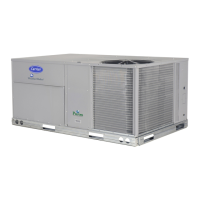63
LEGEND
NOTES:
1. Table 7 illustrates the complete hierarchy. Your menu parameters
may be different depending on your configuration. For example if
you do not have a DCV (CO
2
) sensor, then none of the DCV
parameters appear.
2. When values are displayed, pressing and holding the or but-
ton causes the display to automatically increment.
3. ERV Operation: When in cooling mode AND the conditions are
NOT OK for economizing - the ERV terminal will be energized. In
the Heating mode, the ERV terminal will be energized when the OA
is below the ERV OAT set point in the set point menu.
4. STATUS —> OCCUPIED — The factory-standard Occupancy sig-
nal originates with a thermostat or other controller call for indoor
fan operation at CTB terminal G. This signal passes through the
Central Terminal Board’s OCCUPIED jumper JMP1 to the ECONO
connector and to the W7220’s OCC input terminal. An external
timeclock or relay is required to implement an Occupancy schedule
on the economizer damper position.
5. STATUS —> MA TEMP, SETPOINTS —> MAT SET — The W7220
menu parameters and labels include designations MA, MAT and
Mixed Air for the economizer cooling control sensor. On these roof-
top units, the economizer control sensor is located downstream of
the evaporator/indoor coil in the supply fan section where this sen-
sor is designated as Supply Air Temperature (SAT) sensor.
6. SETPOINTS —> DRYBLB SET — This point is not displayed if a
Return Air (differential) temperature sensor or an Outdoor Air
enthalpy sensor is connected.
7. SYSTEM SETUP parameters must be configured as noted for 2-
Speed unit operation:
EQUIPMENT = CONV
AUX2 IN = W
FAN SPEED = 2SPEED
For damper minimum position settings and checkout menu
readings, see Table 8. For dry bulb operation with a 1 speed in-
door fan, with or without DCV, see Tables 9 and 10. For enthal-
py operation with a 1 speed indoor fan, with or without DCV,
see Tables 11 and 12. For dry bulb operation with a 2 speed in-
door fan, with or without DCV, see Tables 13 and 14. For en-
thalpy operation with a 2 speed indoor fan, with or without
DCV, see Tables 15 and 16.
Table 8 — Damper Minimum Position Settings and Readings on Checkout Menu
ALARMS
(cont)
DMP CAL RUNNING N/A N/A DAMPER CALIBRATION ROUTINE RUNNING
If DCV Auto enable has been programmed, when the W7220 is
completing a calibration on the dampers, this alarm will display.
Wait until the calibration is completed and the alarm
will
go
away. Must have OA, MA and RA sensors for DCV calibration;
set up in the Advanced setup menu.
DA SENS ALM N/A N/A DISCHARGE AIR TEMPERATURE SENSOR ALARM
Discharge air temperature is out of the range set in the
ADVANCED SETUP Menu. Check the temperature of the dis-
charge air.
SYS ALARM N/A N/A When AUX1-O is set to SYS and there is any alarm (e.g., failed
sensors, etc.), the AUX1-O terminal has 24 vac out.
ACT UNDER V N/A N/A ACTUATOR VOLTAGE LOW
Voltage received by actuator is above expected range.
ACT OVER V N/A N/A ACTUATOR VOLTAGE HIGH
Voltage received by actuator is below expected range.
ACT STALLED N/A N/A ACTUATOR STALLED
Actuator stopped before achieving commanded position.
Table 7 — Menu Structure (cont)
MENU PARAMETER
PARAMETER
DEFAULT
VALUE
PARAMETER
RANGE AND
INCREMENT
NOTES
CLO — Compressor Lockout
ERV — Energy Recovery Ventilator
LCD — Liquid Crystal Display
MA — Mixed Air
MAT — Mixed Air Temperature
N/A — Not Applicable
OA — Outdoor Air
OAT — Outdoor Air Temperature
OCC — Occupied
RA — Return Air
RAT — Return Air Temperature
RTU — Rooftop Unit
SYS — System
DEMAND CONTROLLED
VENTILATION
(CO
2
SENSOR)
FAN SPEED SETPOINTS CHECKOUT
NO
1
MIN POS VMAX–HS
N/A N/A
2
MIN POS H VMAX–HS
MIN POS L VMAX–LS
YES
1
VENT MIN VMAX–HS
VENT MAX VMAX–HS
2
VENT MIN H VMAX–HS
VENT MAX H VMAX–LS
VENT MIN L N/A
VENT MAX L N/A

